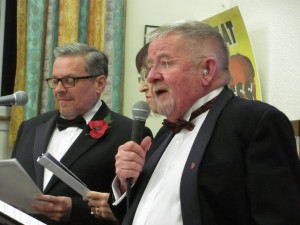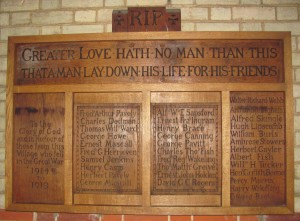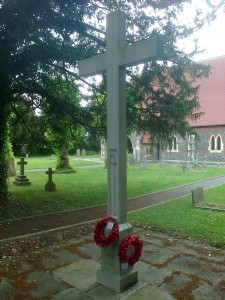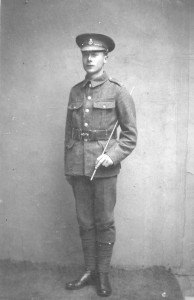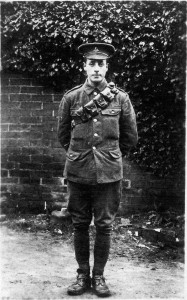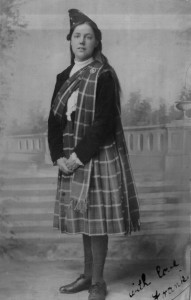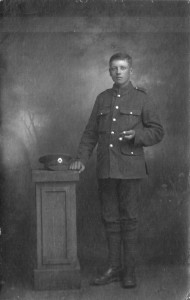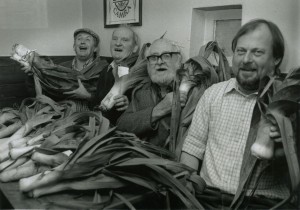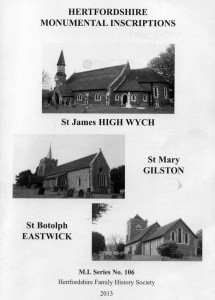This article is written about and dedicated to Miss Fane, a grand and eccentric lady. Many older people in East Hertfordshire still remember her. For that very reason it has been very difficult to separate fact from fiction. Sadly I have been unable to talk to some primary sources. If as a result, inaccuracies have crept in to what is written below, I apologise beforehand.
Valentine Cecil Fane was born on the 30th January 1893 in Nazeing Essex, the daughter of Cecil Fane and Alice Goddard. Related to the Earl of Westmoreland, she came from a privileged and wealthy background. Her grandfather, John William Fane was an MP, a Justice of the Peace and a deputy lieutenant of Oxfordshire who married four times. The ancestral home of the Fanes was Wormsley Park in Oxfordshire, later the home of John Paul Getty, now the home of his son Mark Getty. Valentine’s father Cecil Fane was an Eton-educated civil engineer. In 1899, when Valentine was only six, her mother died. Father and daughter settled at Malting Farm, Little Hallingbury.

The 1901 census: father Cecil and daughter Valentine at Malting Farm Little Hallingbury
Most probably young Valentine was educated at home although I have been unable to find proof, i.e. mention of a live-in governess. Then, at some point towards 1910, Cecil, Valentine’s father took a job as land agent in Bingley, Yorkshire, and Valentine moved in with her maternal grandparents. The 1911 census lists Valentine residing with them at the Nazeing vicarage. It must have been around that time that she started to write poetry and, during a visit to the Opera, met the love of her life: John Barnard.
Born in 1869, John Barnard was 24 years older than Valentine. He hailed from the Barnard brewing and malting dynasty. John’s nephew was the one time Kidderminster MP and chair of Hertfordshire County Council Edmund Broughton Barnard. Thje Kelly directories listed both uncle and nephew as important local land owners. In 1901 John himself was elected to the Rural District Council representing High Wych. At that time he lived at the Curatage on High Wych Road. John also was a Justice of the Peace. By the time of the 1911 census, he and his mother had moved to Alston Oak on the corner of Redricks Lane and Harlow Road.
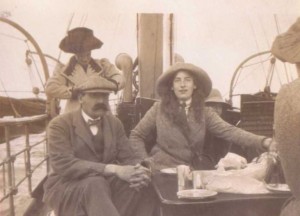 1912: Cecil and Valentine on holiday at Val Ghigha
1912: Cecil and Valentine on holiday at Val Ghigha
What the families on either side thought of Valentine’s and John’s relationship we simply do not know. Traditionally, established aristocracy such as the Fanes would have regarded “trade people” such as the Barnards with some suspicion. Then, in October 1912 Mrs. Barnard, John’s mother, died. John’s dad had already died in 1881. Mother and son had been sharing a house ever since, first in High Wych, later at Alston Oak Sawbridgeworth. Whether John and Valentine’s meeting at the Opera took place before or after Mrs. Barnard’s death we do not know. Still, the loss of a parent is a landmark event in anybody’s life and Valentine Fane must have understood what John B. was going through. She herself had lost her mother when she was only 6. Valentine had also spent quite some time away from her father. They were in some respects kindred souls, thrown together by fate if you want to put it dramatically. 1912 was an eventful year for Valentine. Not only did she meet the love of her life, she also became a published poet and met her dad’s second wife. Looking at the above photograph taken at the island of Ghigha I would say the woman in the background in Marjorie Ferrand, whom Cecil was later to marry. Marjorie was the daughter of Mr. W. Ferrand of St. Ives, Cecil’s Yorkshire employer. Perhaps Cecil had taken his daughter on a trip to Scotland with the express purpose to introduce her to her future stepmother.
Cecil Fane and Florence Marjorie Ferrand married in October 1913, Valentine was a bridesmaid and John Barnard a guest. Whether the two attended the wedding as a couple I did not find out. If they did, it is somehow unlikely there was any ill feeling. It was clear though that John and Valentine were desperately and deeply in love. They may even have been living under the same roof at that time. Why the two of them never married remains a mystery. John Barnard’s will however clearly mentions Valentine as his sole heir. Valentine continued to live at Alston Oak. From the mid-twenties, the Kelly directories list Miss Fane and Edmund Barnard amongst the principal land owners in the area.
Valentine’s poetry shows her to be a sensitive soul with a love of nature and a sense of fun. Her writing was published in Punch, The Windsor Magazine, Grand Magazine and Top Notch, an American magazine. Most of these early poems date from between 1912 and 1915. Her family was certainly proud of her as was shown by the fact that her stepmother carefully cut out her published poems and pasted them in an album.
However, it is the mystery concerning a poem called “the Wind” which really got me interested in Valentine. “The Wind”” was long supposed to have been a late poem written by Ivor Gurney, a poet and composer, who sadly ended his days in a psychiatric institution. “The Wind” was written on the back of some Oxford University Press letterhead. Gurney initialled it “IG” and also wrote “Valentine Fane: on the paper, the implication being that he liked the poem, related to it and wanted to remember who wrote it so he wrote Valentine’s name by his own. This led to some literary critics suggesting Valentine Fane was the product of Ivor Gurney’s imagination. This assumption was however contradicted by Pam Blevins, Gurney’s biographer who took a lot of trouble to find out about Valentine Fane. Pam got in touch with Sheila Johnson, a niece of Valentine. Both Pam and Sheila have been very helpful in my research.
Below you will find two poems written (or most probably written) by Valentine Fane. One “On the back of a Bike” shows her humorous side and her love of motor vehicles. “The Wind”, if indeed written by her, shows her as the restless, pained soul she must have been.
The Back of a Bike
If you’re feeling “fed up” and in need of a thrill,
There’s a topping sensation you’re certain to like;
Let your latest young man take you out, if he can,
On the back of his new motor-bike.
It is perfectly safe, there’d no chance of a spill,
There is nothing on earth to alarm you, but still
You’ll be planning your will as you rush down the hill
When you ride on the back of a bike!
It’s not very easy to do it with grace,
And people regard you with fear and dislike-
But a motor’s no go and a side-car’s too “slow”
So nothing remains but the bike.
The corners are really far worse than the pace,
And you clutch your companion with frenzied embrace,
While an anxious expression is fixed on your face
(Just in case) as you race well-all over the place,
When you ride on the back of a bike.
Valentine Fane.
———————————————————————————
The Wind
All night the fierce wind blew –
All night I knew
Time, like a dark wind, blowing
All days, all lives, all memories
Down empty endless skies –
A blind wind, strowing
Bright leaves of life’s torn tree
through blank eternity:
Dreadfully swift, Time blew.
All night I knew
the outrush of its going.
At dawn a thin rain wept.
Worn out, I slept
And woke to a fair morning.
My days were amply long, and I
content
In their accomplishment –
Lost the wind’s warning.
Most probably written by Valentine Fane
——————————————————————————–
After John Barnard’s death Valentine continued to live at Alston Oak where she was often visited by her father, his second wife and the children from their marriage. Judging from the reports in the family album she was a popular older sister. That same family album also records a memorable occasion in February 1926 when both father Cecil and daughter Valentine starred in “Eliza comes to stay” a play staged in the Jubilee Hall in Malpas where Cecil Fane then lived. In 1927 another memorable event, Valentine was presented at court. It was rather upsetting though that on the day before that presentation, she had frocks and jewellery stolen from her car while she was with her dressmaker. 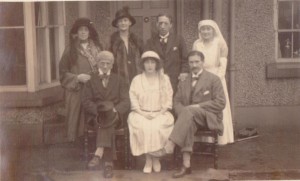
The cast of Eliza comes to stay – VF in the middle at the front
Returning to the subject of poetry, there are the “garage poems”. Amongst material shown to me by Sheila Johnson was a brochure from a garage in Tenby South Wales. The brochure advertises day trips organised by that garage or coach company, illustrated with scenic photographs and accompanied by a series of poems that describe various places on the tours. The poems very much reflect Miss Fane’s style, her sense of humour and her keen descriptive powers. As Miss Fane owned or part-owned a garage in Wales it is seems obvious that she produced these poems to enhance their promotional literature. Pam Blevins is in no doubt they were in fact written by Valentine Fane.
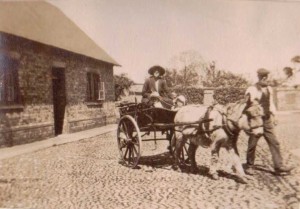

A family visit at Alston Oak
At some point in the thirties Valentine then moved out of Alston Oak and into Carters, another property bequeathed to her by John Barnard. There she spent the rest of her lonely life, occasionally visited by family and friends. Sheila Johnson, her niece, who came to Carters together with her father, VF’s half-brother, remembers her as a heavy smoker with skirts down to her ankles. She was a very gentle soul. Slim, not tall and fair in appearance her family members considered her quite clever. Despite her wealth Miss Fane did not live in great comfort. Modern amenities such as gas, electricity and running water were absent at Carters. Water was drawn from a well. Chickens ran about, not just in the garden but even in the kitchen. The absence of electricity meant that the house was in darkness. Once, so the story goes, a visiting doctor was mistaken for a burglar and nearly attacked by a frightened Valentine.
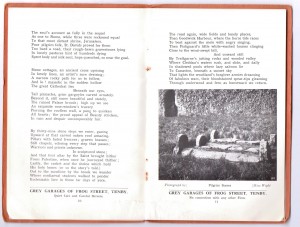
Two pages from “the Garage Poems”
There was however a collection of vintage cars. Some villagers remember her driving about in one of those; the back of her vehicle filled up with boxes. Eric Willison who worked at the post office in the sixties remembers Miss Fane “turning up with parcels from which a gamey smell emanated”. Though Valentine was an animal lover, hunts were held on her land; the “gamey parcels” must have resulted from those occasions.
Lily Mynott, who came to High Wych, in 1943 had a milk round and Valentine Fane was one of her customers. She remembers Miss Fane as a kind and friendly lady. “How elegant she looked as she attended village fetes at the Grange”. Nigel Rivers tells of her love of animals. “She was even reluctant to kill rats. She told me they were her friends” It did not stop her having pheasants shot on her grounds however. Despite her wealth it should be said Valentine Fane was letting herself go. Her finances were not handled in the best of manners. She also became more and more dependent on the people who worked for her. As a result Miss Fane took to living and sleeping in the downstairs kitchen. After a while though, that arrangement too became impractical and the Warwicks the family who lived in Carters Cottage took her in, prepared her meals and generally looked after her. Every now and then she went for dinner at the Wentworth Stanley house. Oliver Stanley later bought one of her properties.
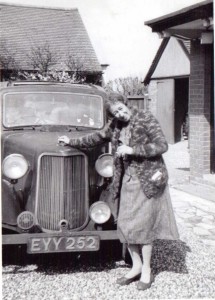
Miss Fane in later life

The grave stone at Little Hallingbury
Miss Fane was a very generous person. Already in 1926 she financed the restoration of stained glass windows designed by Archibald Nicholson at St. Mary’s Church, Lindsell. In later life at Christmas time it was her custom to send cakes to the local police constable, the doctor, the vicar, the postman and key staff.
The sad reality was however that Valentine Fane spent all that time, from 1918 until 1977 mourning for John Barnard the love of her life. Not much of consequence happened in all those years. In January 1959 Miss Fane was in court for driving a car without due care and attention. In the late sixties – early seventies there was a fire and there was also at least one burglary. On one of these occasions, it is said, she was attacked. It made her even more dependent on the people that worked for her.
Valentine Fane died in Herts and Essex Hospital Bishops Stortford on the 11th January 1977. Her cousin and god daughter Valentine Sillery was at her bedside and co-signed the death certificate which mentioned bronchopneumonia as cause of death. Miss Fane was buried in Little Hallingbury Church Yard.
The last will and testament of Miss Fane makes for an interesting read. There is the strange stipulation that “before my burial the doctor attending …… shall first sever the artery in my wrist in order to make certain that I am dead”. Valentine’s half brothers and sisters each receive the sum of £500. Five named people receive £100 each and a further twelve receive £50. Some of her staff were given a year’s salary and the right to remain at their cottage free of rent and charges for two years. Clause 11 states that VF’s animals should be taken care of “until such time as they will have made arrangements for their future” and sets aside £ 1000 to pay for this. Clause 15 than states that “the reason that I have not made more specific bequests even though I have verbally promised to leave certain articles to friends or members of my family is that the majority of the articles have either been stolen or lost in the fire”
A sad and lonely life had come to an end
Sources for this article were Pam Blevins, Sheila Johnson, the Fane family album, Lily Mynott, Nigel Rivers, Janet van de Bilt, the H&E Observer and the staff at HALS.
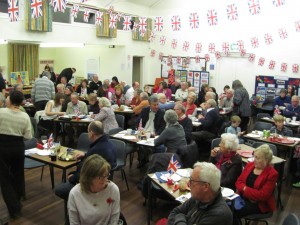 A full house in our village hall !!
A full house in our village hall !!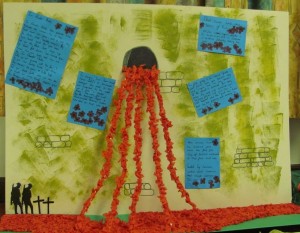 Some project work from HW school
Some project work from HW school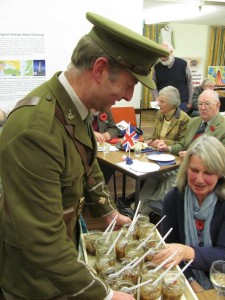 “Major Sam Clark” serves up the autumn chutney
“Major Sam Clark” serves up the autumn chutney
